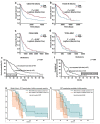Recapitulating the Key Advances in the Diagnosis and Prognosis of High-Grade Gliomas: Second Half of 2021 Update
- PMID: 37047356
- PMCID: PMC10094646
- DOI: 10.3390/ijms24076375
Recapitulating the Key Advances in the Diagnosis and Prognosis of High-Grade Gliomas: Second Half of 2021 Update
Abstract
High-grade gliomas (World Health Organization grades III and IV) are the most frequent and fatal brain tumors, with median overall survivals of 24-72 and 14-16 months, respectively. We reviewed the progress in the diagnosis and prognosis of high-grade gliomas published in the second half of 2021. A literature search was performed in PubMed using the general terms "radio* and gliom*" and a time limit from 1 July 2021 to 31 December 2021. Important advances were provided in both imaging and non-imaging diagnoses of these hard-to-treat cancers. Our prognostic capacity also increased during the second half of 2021. This review article demonstrates slow, but steady improvements, both scientifically and technically, which express an increased chance that patients with high-grade gliomas may be correctly diagnosed without invasive procedures. The prognosis of those patients strictly depends on the final results of that complex diagnostic process, with widely varying survival rates.
Keywords: CNS; MRI; diagnosis; glioma; neuroradiology; non-imaging diagnosis; nuclear medicine; prognosis; tumor.
Conflict of interest statement
The author declares no conflict of interest.
Figures







Similar articles
-
The prognostic value of clinical factors and cancer stem cell-related markers in gliomas.Dan Med J. 2014 Oct;61(10):B4944. Dan Med J. 2014. PMID: 25283629
-
Pediatric Gliomas: Current Concepts on Diagnosis, Biology, and Clinical Management.J Clin Oncol. 2017 Jul 20;35(21):2370-2377. doi: 10.1200/JCO.2017.73.0242. Epub 2017 Jun 22. J Clin Oncol. 2017. PMID: 28640698 Review.
-
Low Grade Gliomas in Children.J Child Neurol. 2016 Mar;31(4):517-22. doi: 10.1177/0883073815599259. Epub 2015 Aug 18. J Child Neurol. 2016. PMID: 26286938 Review.
-
Long-term prognostic assessment of 185 newly diagnosed gliomas: Grade III glioma showed prognosis comparable to that of Grade II glioma.Jpn J Clin Oncol. 2008 Nov;38(11):730-3. doi: 10.1093/jjco/hyn099. Epub 2008 Sep 26. Jpn J Clin Oncol. 2008. PMID: 18820008
-
Low-grade gliomas: when and how to treat.Hematol Oncol Clin North Am. 2012 Aug;26(4):797-809. doi: 10.1016/j.hoc.2012.05.001. Epub 2012 Jun 7. Hematol Oncol Clin North Am. 2012. PMID: 22794284 Review.
Cited by
-
Integrative Oncology for High-Grade Glioma: A Case Report on the Combined Effects of Oncothermia and Complementary Therapies.Cureus. 2024 Aug 9;16(8):e66492. doi: 10.7759/cureus.66492. eCollection 2024 Aug. Cureus. 2024. PMID: 39246981 Free PMC article.
-
The impact of sociodemographic background on clinical presentation of high-grade gliomas: a multi-institutional retrospective analysis.J Neurooncol. 2025 Jul;173(3):529-536. doi: 10.1007/s11060-025-05012-1. Epub 2025 Mar 25. J Neurooncol. 2025. PMID: 40131577 Free PMC article.
-
High-Grade Glioma Recurrence Is Delayed in Hispanic Patients despite Severe Social Vulnerability: A Retrospective Cohort Study.Cancers (Basel). 2024 Apr 20;16(8):1579. doi: 10.3390/cancers16081579. Cancers (Basel). 2024. PMID: 38672661 Free PMC article.
-
Confocal Laser Endomicroscopy: Enhancing Intraoperative Decision Making in Neurosurgery.Diagnostics (Basel). 2025 Feb 19;15(4):499. doi: 10.3390/diagnostics15040499. Diagnostics (Basel). 2025. PMID: 40002650 Free PMC article. Review.
-
The Immunomodulatory Effects of Vitamin D on COVID-19 Induced Glioblastoma Recurrence via the PI3K-AKT Signaling Pathway.Int J Mol Sci. 2024 Dec 2;25(23):12952. doi: 10.3390/ijms252312952. Int J Mol Sci. 2024. PMID: 39684661 Free PMC article.
References
-
- Global Burden of Disease Cancer Collaboration. Fitzmaurice C., Abate D., Abbasi N., Abbastabar H., Abd-Allah F., Abdel-Rahman O., Abdelalim A., Abdoli A., Abdollahpour I., et al. Global, Regional, and National Cancer Incidence, Mortality, Years of Life Lost, Years Lived with Disability, and Disability-Adjusted Life-Years for 29 Cancer Groups, 1990 to 2017: A Systematic Analysis for the Global Burden of Disease Study. JAMA Oncol. 2019;5:1749–1768. - PMC - PubMed
Publication types
MeSH terms
LinkOut - more resources
Full Text Sources
Medical

